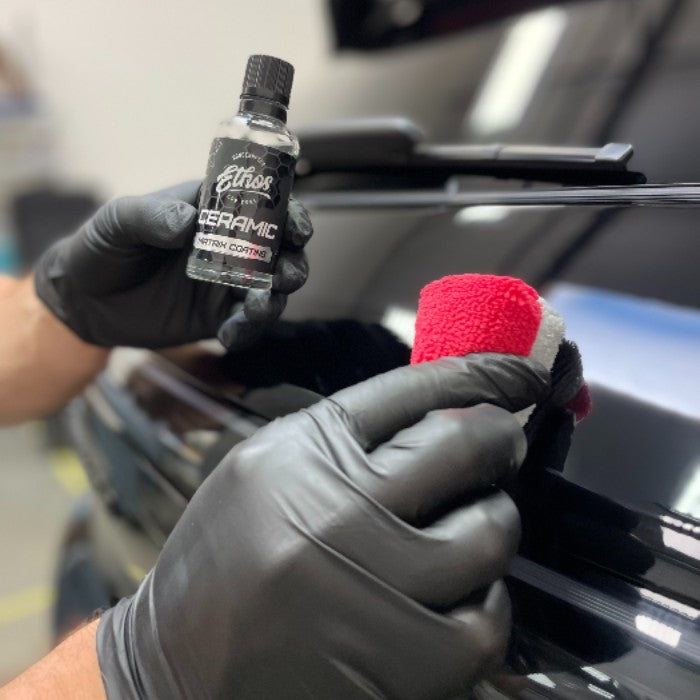Discovering the Scientific Research Behind Car Ceramic Coating and Its Safety Residences
The science of car ceramic coating provides a remarkable research study in sophisticated automobile defense. Composed largely of silicon dioxide and polymers, these coatings create a robust bond with vehicle paint. This communication improves toughness against environmental risks while using hydrophobic advantages. Nonetheless, the complexities of how these coverings work and their lasting advantages continue to be less understood. Unloading these information exposes why ceramic finishes are becoming a favored option for car treatment
What Is Ceramic Coating?
Ceramic coating is a fluid polymer that chemically bonds to the surface of a lorry's paint. This innovative safety layer boosts longevity and offers premium resistance to ecological factors. Unlike standard wax or sealers, which supply temporary security, ceramic finishes produce a lasting guard that can withstand harsh problems such as UV rays, acidic pollutants, and severe weather condition. When used correctly, the coating develops a hydrophobic surface, triggering water to bead and slide off, which helps in preserving the car's cleanliness. Furthermore, it uses enhanced gloss and depth to the paint, making the lorry show up more polished and vibrant. The application procedure generally includes comprehensive surface prep work, including cleansing and sprucing up, to assure peak bonding. Therefore, ceramic coatings are becoming progressively preferred among car fanatics and those looking for to secure their financial investments, guaranteeing to maintain the automobile's aesthetic appeal while decreasing the regularity of upkeep.
The Make-up of Ceramic Coatings
The elaborate solution of ceramic coatings primarily consists of silicon dioxide (SiO2), which is acquired from natural sources like quartz and sand. This crucial component gives the structure for the coating's durability and protective top qualities. Along with SiO2, ceramic finishes frequently consist of various polymers and additives that enhance bond, versatility, and resistance to ecological elements. These substances function synergistically to produce a durable obstacle versus pollutants such as dust, chemicals, and UV rays.Furthermore, some formulas incorporate titanium dioxide (TiO2) or various other nanomaterials, which can enhance the coating's hydrophobic residential properties, leading to better water repellency. The exact make-up can vary greatly among makers, influencing performance and long life. Ultimately, the combination of these components culminates in a safety layer that not just improves the aesthetic allure of vehicles however also offers to extend their life expectancy by shielding the surface area from possible damage.
Just How Ceramic Coatings Work
Understanding just how ceramic finishings work involves exploring their chemical make-up, which adds to their protective top qualities. The application procedure is essential for attaining excellent results, while durability and durability elements determine the coating's effectiveness in time. Together, these elements highlight the advantages and efficiency of ceramic coatings for car protection.
Chemical Structure Explained
While lots of car owners look for long-lasting protection for their automobiles, the chemical composition of ceramic layers plays an essential duty in their effectiveness. These finishes largely contain silicon dioxide (SiO2), which is acquired from natural minerals. This compound forms a strong bond with the automobile's paint, creating a sturdy, safety layer. Additionally, numerous ceramic layers contain titanium dioxide (TiO2), boosting their hydrophobic residential or commercial properties and resistance to UV rays. The presence of polysiloxanes can even more improve flexibility and durability. Together, these elements add to the coating's ability to fend off water, dust, and impurities, while additionally providing a high-gloss coating. Comprehending this chemical foundation assists car owners value the robust protection provided by ceramic coatings.
Application Process Summary
Applying ceramic finishes entails a precise process that guarantees optimal bonding and protection for the automobile's surface area. Complete cleaning and decontamination of the car's outside are performed to eliminate dirt, crud, and previous waxes. This action validates that the surface is devoid of contaminations that might hinder adhesion. Following this, the paint is usually brightened to enhance quality and eliminate any type of flaws. When prepared, the ceramic coating is applied in small sections utilizing an applicator pad, permitting uniform coverage. The coating is then entrusted to heal, have a peek at this website developing a solid chemical bond with the surface. Appropriate treating times and conditions are critical, as they verify the coating achieves its optimum effectiveness and protective qualities.
Longevity and Durability Aspects
Ceramic finishes are developed to supply durable protection with their sophisticated chemical structure, which develops a durable obstacle versus ecological pollutants. The sturdiness of these finishes is influenced by elements such as the density of the application, the top quality of the product, and the problems under which the lorry is exposed. High-grade ceramic coverings can last several years, resisting scratches, UV rays, and chemical stains. Correct maintenance, consisting of regular washing and routine reapplication, can even more enhance long life. Furthermore, environmental elements like environment and direct exposure to toxins can influence the lifespan of the coating. Generally, when applied and preserved properly, ceramic finishes provide extraordinary toughness, making them a preferred option for car enthusiasts looking for to protect their car's look.
Hydrophobic Characteristics and Water Repellency
Hydrophobic homes are a trademark of top quality car ceramic layers, significantly enhancing the automobile's surface performance. These finishings develop a molecular bond with the car's paint, causing a surface that fends off water efficiently. When water comes into contact with a ceramic-coated surface, it grains up and rolls off, minimizing the amount of liquid that stays on the paint. This behavior not just contributes to a visually pleasing appearance yet additionally reduces the accumulation of pollutants such as dust, grime, and roadway salts.The boosted water repellency results in less complicated cleaning and maintenance, as less effort is required to get rid of unwanted compounds. Additionally, the hydrophobic nature of ceramic finishings aids in stopping water areas, which can mar the surface of uncoated surface areas. Generally, the consolidation of hydrophobic residential properties in ceramic finishes plays an essential function in preserving the vehicle's immaculate appearance while simplifying upkeep.
Security Against Scratches and UV Damage
Car ceramic finishings use significant security against scrapes and UV damage. The scratch resistance mechanism produces a long lasting layer that takes in influences, while the UV securing advantages assist keep the lorry's paint stability in time. With each other, these attributes add to a longer-lasting and aesthetically attractive finish.
Damage Resistance System
Utilizing advanced innovation, ceramic finishes provide a durable shield against scratches and UV damages, enhancing the longevity and look of automobile surface areas. The scratch resistance mechanism of these layers is connected to their unique molecular structure, which forms a durable bond with the automobile's paint. This bond develops a hard, protective layer that can take in effects and withstand abrasions. Furthermore, the smooth surface area of the coating minimizes rubbing, making it tough for contaminants to adhere and create scrapes. The chemical composition of ceramic finishes commonly consists of nanoparticles that reinforce the safety layer, further improving its durability. Subsequently, lorries treated with ceramic finishes exhibit markedly boosted scrape resistance compared to standard wax or sealants, making certain an immaculate surface with time.
UV Shielding Perks
The safety qualities of ceramic coverings prolong past scratch resistance to include significant UV securing advantages. These coverings create a robust barrier that shows harmful ultraviolet rays, safeguarding the lorry's paint and underlying products. Prolonged direct exposure to UV radiation can result in fading, oxidation, and degeneration of the paint coating. By including ceramic coverings, vehicle proprietors can efficiently mitigate these threats, preserving the visual appeal and stability of their automobiles. Additionally, the UV blocking properties add to improved longevity, lowering the regularity of painting and upkeep. Ultimately, the combination of ceramic layers provides an extensive option for safeguarding cars i loved this from the destructive impacts of sun exposure, ensuring a continual, vivid appearance in time.
The Longevity and Maintenance of Ceramic Coatings

Often Asked Concerns
Can Ceramic Coating Be Applied to Any Kind Of Kind of Lorry?
Ceramic coating can be put on numerous kinds of vehicles, consisting of cars, vehicles, and motorbikes. Surface prep work and compatibility with specific products are crucial for ideal attachment and efficiency of the coating.
Just How Much Does Ceramic Coating Generally Cost?
Ceramic coating normally sets you back between $500 and $2,000, relying on variables such as lorry dimension, coating quality, and expert application. The financial investment can supply lasting defense and boost the automobile's appearance over time.

Is Expert Application Necessary for Best Results?
The necessity of professional application usually depends upon wanted results. Specialists generally guarantee correct surface prep work and application techniques, leading to perfect bonding and longevity of the coating, which may be testing for inexperienced individuals to achieve.
Can Ceramic Coatings Be Removed or Repaired?
Ceramic finishings can be gotten rid of or fixed, though the process might need specific solvents or strategies - Ceramic Coating Newark. Appropriate elimination is vital to stay clear of damages to the underlying surface, highlighting the significance of professional help for suitable results
Exactly How Does Porcelain Coating Compare to Standard Wax?
The contrast between ceramic coating and standard wax discloses that ceramic finishes offer premium durability, enhanced protection versus ecological impurities, and longer-lasting sparkle, while wax requires much more constant application and offers less total resistance to damages.